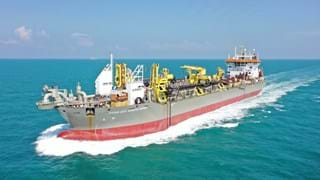The 4th largest container terminal in the world is located in the South East of the South Korean peninsula at Busan. As the old port is completely surrounded by the metro-city, expansion of the old port is restricted. To solve the chronic phenomenon of cargo congestion MOMAF (Ministry of Marine and Fisheries) decided in 1997 to construct a new port situated 20 km west of Busan with a final total handling capacity of 4.6 million TEU and total expenses of 4.2 billion USD.
Busan New Port was constructed in a naturally sheltered area behind Gadukdo Island. Busan New Port was constructed in 2 phases. Phase 1 was a 1,490 meter breakwater and 22.7 km of embankment for future reclamation works. For this phase a total of 55 million m<sup>3</sup> was dredged, whereof 30 million m<sup>3</sup> of sand for reclamation works. The project was awarded to a consortium of 11 Korean contractors, of which Samsung is the leading party for North Container Terminal (quay wall construction, dredging and reclamation and container yard).
Boskalis was awarded the dredging works of the removal of some 2.5 million m<sup>3</sup> of silt and clay. The depth at commencement of the works varied from 7.5 m up to 8.5 m. Dredging was to be made up to 12 m below Chart Datum. Since no land disposal sites were available at that stage of the project the material had to be taken away to an offshore dumping location. The dumping grounds were located at 35 km distance.


